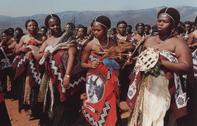
Wearing of Blankets and Cloth
Arts and Crafts in Rural South Africa
Following the widespread introduction of imported cotton in the course of the 19th century, rural women have been enthusiastic sewers. Skills associated with the adoption of European styles of dress were initially taught to Christian converts by missionary wives.
The Resident Magistrate of Berea, Lesotho, noted in 1879 that "The demand for European clothing is steadily increasing”. Throughout South Africa, rural communities continue to wear dress styles inspired by 19th century European examples.
Many rural women are enthusiastic sewers. Although most now use manual sewing machines, the techniques employed in the production of various kinds of garments is often extremely time-consuming. Embroidered patterns often include beadwork details.
Cloths and blankets are often adapted, for example through the addition of braiding and safety pins. Other recycled embellishments include springs and plastic found-objects.
Some communities now wear commercially manufactured cloths intended specifically for these markets. The striped, multi-coloured cloths worn by Venda women on special occasions such as weddings are now frequently sold online. Called wenda, these garments include a length of cloth with a strip (bannda) sewn across the top.
Wearers often signal their loyalties and affiliation through the commemorative cloths they purchase. Swazi women, for example, regularly drape themselves in red, white and black Swati kangas incorporating photographic prints of King Mswati III.
By
Professor Sandra Klopper










